Otter links Certain of the above groups are also compatible to interbreed without damaging gene interaction. Groups 1 and 2 may be interbred with few consequences as may Groups 3 and 4. Groups 5 and 6 may be interbred because of the incomplete action of the e and e-j genes. Groups 5 and 6 can be interbred with Groups 1 and 2 without serious consequences, but not with Groups 3, 4, 7 or 9. "Lynx mini rex, Plain Talk" by Dr. Steve RoushGroup 1 - Castor, Lynx, Opal, Cinnamon Photo and Genetics Color Crossing Guidelines Color Standards C & A 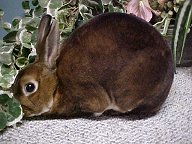
**CASTOR- is our 1st color in Group 1- there are many variations of castor color, some too gray, some too light, and some too dark. The castors that are doing so well on the show table today should not be crossed with other colors- it will only do harm. Breeding a red in one time to intensify the red band is fine if your castors are gray, but you should only breed Castor to Castor after that. Any reds produced from a Castor/red cross should probably be culled as they may carry heavy ear lacing and blue under color. Breeding to Opal will cause the Castor offspring to carry too much black on the surface color, and be very gray around the lower hind quarters. CASTOR - A gorgeous mahogney or chestnut brown color with black tipping is the ideal color for castor mini rex- or like a beaver pelt. The intermediate rufus colored ring band should take up 50% of the hair shaft and the slate blue undercolor the other 50%. If the ring band is narrow it usually is because the tipping is too heavy. Eyes are brown 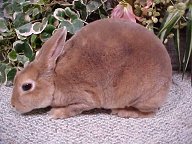
Lynx**LYNX-is the 2nd color shown in Group 1- rather than cross a lynx with a rabbit from Group 1 -it is more advised to cross them with a chocolate from Group 2(as advised by Dr. Steve Roush and Diane Campbell from her article in the Mini Rex Guidebook) (see authors personal opinion below). Breeding Lynx to castors will result in Castors with incorrect ear lacing and top color. LYNX-The surface color of the top and the sides of the body should be a light orange; which is lightly tipped with lilac. The intermediate band is to be as bright an orange as possible, clearly defined over white under color. Eyes are blue gray 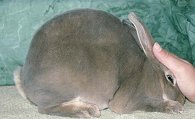
Owned by Dori Goodall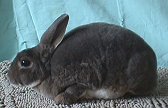
Opal
TLC's Juliet
owned by Hay Bunny Farm**OPAL -is the 3rd color and here we show a young opal on the top and a mature opal in the last photo. Opal is the dilute of Castor, but breeding to castor is not recommended as the blue band of surface color on an Opal is wider than the black surface band on a Castor and breedings usually result in too many of the Castor offspring having way too much black surface color. Do not breed to Lynx, this harms both colors, causing too heavy of a blue surface on the Lynx and very poor ring band on the Opals that result from such a cross. Opal may be bred to Blue or less desirably to Black. OPAL- The surface color of the top and sides of the body is to be a rich medium blue. The intermediate color is to be a golden fawn clearly defined over a slate-blue under color. Eyes- blue-gray Cinnamon Soon CINNAMONS-- are basically castors without the black surface color. They are unshowable but can be used as a red would be used to add brighter ring color to a castor with too gray of a color. Group #2 - Black, Blue, Chocolate, Lilac Photo and Genetics Color Crossing Guidelines Color Standards C & aa 
Black**BLACK- Black may be bred to Blue because Blue is actually a dilute of Black and may help your get your richest, deepest Blues while maintaining good dark pigment color on toe nails, which is a common problem in Blues. Black may also be bred to Tortoise from Color Group 5. BLACK- The entire body is to be a rich lustrous black, which runs deep towards the skin to a slate blue under color. Eyes- dark brown 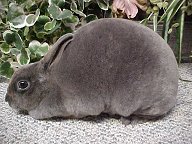
Blue**BLUE- Blue may be bred to Black and also to Opal, but the Opal will be dominant over the Blue. Some breeders also will cross Chocolate and Lilac with the Blues and Blacks. BLUE- The entire body should be a rich levi blue, which runs deep to the skin to a medium blue under color. The guard hairs cannot be a different color than the body color. Eyes are blue-gray 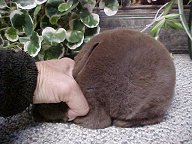
Chocolate**CHOCOLATE- Chocolate and Lilac can be bred together as Lilac is the dilute of Chocolate. Chocolate may also be bred to Black or to Blue. If they must be bred into the agouti group, then Lynx (Color Group 1) would be the only choice. Breeding to Castors will result in Castors with incorrect ear lacing and top color. CHOCOLATE- The surface color should be a hershey chocolate brown, which runs towards the skin to a dove-gray under color. Eyes- brown, ruby cast permissible. 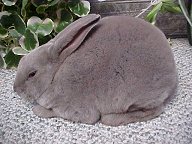
Lilac**LILAC- Lilac may be bred to Chocolate at it is the dilute of Chocolate. You may also breed it to the dilute color blue but try to stay away from Black (Black is always dominant) LILAC- The color should be a medium gray (the color of a dove) , with a light pink tint on the surface. Eyes: Blue gray. Group #3 - Seal, Sable, Siamese Photo and Genetics Color Crossing Guidelines Color Standards aa & ch
Seal Photo Soon**SEAL-While Seals do show up out of Black litters or any other for that matter, it is best to only breed Seal to other Seals for the best color development and to avoid confusing the very dark Seals with faded blacks. SEAL-The Surface color is dark brown, almost black, which shades to a slightly paler brown on the flanks, chest and belly. Think Sea World seal color. undercolor is to be lighter than the surface color. Eyes- brown Sable Photo Soon **SABLE- SABLE- . Siamese Photo Soon **SIAMESE- SIAMESE- . Group #4 - Chin, Beige Photo and Genetics Color Crossing Guidelines Color Standards A & ch 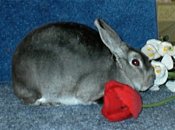
Chinchilla
Owned and bred by Treasure Bechtol.**CHINCHILLA-These are Agouti colored rabbits that lack the orange or red band on the hair shaft. Chinchilla to Chinchilla is best, however, they could be bred to Blacks or less desirably to blue. Do not breed them to Castor, Lynx, Opal or Red, as traces of the orange color will remain for generations. They should also never be bred to any shaded rabbits such as a Himalayan. CHINCHILLA- When looking at a chin, the color appears to be a blend of black and pearl. A narrow black band tipped by black and pearl meets a ticked surface color over a narrow black band. An intermediate band of pearl follows over a wider band of slate-blue under color. Eyes- brown, blue-gray permissible. Beige Photo Soon **BEIGE- BEIGE- Group #5 - Red, Fawn, Tort Photo and Genetics Color Crossing Guidelines Color Standards ee 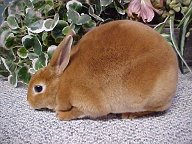
Red**RED-Genetically these are agouti colored rabbits, but what we are looking for is the appearance of a 'self' colored rabbit. It is difficult to find good Red Mini Rex that don't retain some lingering signs of their castor origins by the way of dark ear lacing or blue under color. Again clean reds to clean reds is the best way to go. Crossing out to other colors is not recommended. RED- The surface color of the top and the sides of the body is an even color of red- like Lucille Ball red. Ideally, the surface color is free of smut. Eyes are brown. Fawn Photo Soon **FAWN- FAWN- 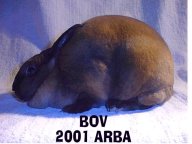
Tort
Bred by Mike Winstead**TORT - Tort is not one of our most developed colors, but can be beautiful when it has the proper clean saddle and good dark points. Breed torts to each other or to Black. They may also be bred to Reds to clean and brighten the body of saddle color, but the first generation will more likely be poor colored Reds, and you will have to cull heavily. May also be bred to tricolors. TORT- The surface color of the body is to be a bright, rich, clean orange ( a little deeper than a red rabbits orange) which thens blends into a smokey gray-black on the side, hind-end, stomach, and feet. The undercolor is a blue/white color. Eyes- brown Group #6 - Tricolor, Harlequin, Magpie Photo and Genetics Color Crossing Guidelines Color Standards e-j-e or e-j-e-j 
Tri
Owned and bred by Treasure Bechtol.**TRI-COLOR -These should be bred to each other, or to harlequins, which are just solid tricolors. They may also be bred to broken reds with some success but never, never to any rabbit in the agouti group. Note: Torts can be used to brighten color, however, it makes tort colored nose and ears very common which is a disqualification. TRI-COLOR - consists of white in conjunction with one of the following combination of two colors: Black and Orange; Lilac and Fawn; Chocolate and Orange; or Blue with Fawn. Eyes- brown in Black and Chocolate varieties: blue-gray in Lilac and Blue Varieties. HARLEQUIN 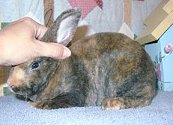

Photo courtesy of Dori Goodall**HARLEQUIN - HARLEQUIN - MAGPIE Photo Soon **MAGPIE - MAGPIE - Group #7 - All color of Otter Photo and Genetics Color Crossing Guidelines Color Standards a-t-a-t & C 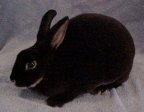
Black Otter
Owned and bred by Armando Cabrerra
Shanahan's , Cabrera'sOTTER - I did work with Black Otter Standard Rex and again for the best color you want otter to otter. Black and Blue otter to each other and Chocolate and Lilac otter to each other- again the Blue and Lilac otter could probably work together. If you only have one Black Otter you could cross to a solid black rabbit, etc., OTTER - For a rough draft of a working standard on otters see Shanahan's web site (Neva wrote this rough draft and is not working with Armando). They will make their 1st presentation at ARBA Convention in 2002 by Armando Cabrerra. Group #8 - Californian or Himalayan Photo and Genetics Color Crossing Guidelines Color Standards C-H,-CH 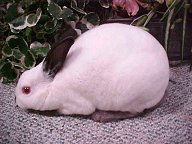
Himi**HIMI -Breed only himi to himi for the best color development of points. If you breed out to other colors it will take several generations to correct the color. It is good to breed to black which will darken point color correctly. First generation you will get all blacks, save these and breed them back to your himi's. HIMI --(Black or Blue) The body color is white. The ears, nose, feet and tail are as dark a black or blue as possible. The nose marking and is to be well rounded and distinct. Eye Color- pink Group #9 - White Photo and Genetics Color Crossing Guidelines Color Standards cc 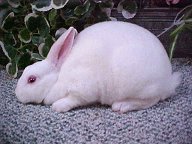
REW**REW -It is best to breed REW to REW. Breeding them to solid colors is not recommended as it can cause white hairs, white spots,and white toe nails in colored rabbits for many generations. Remember REW'S are albino which means they carry color genes, though masked by the albino gene. Looking at a pedigree can help determine what color genes a REW carries. A REW can also mask the broken gene and in that case you could breed a REW to a broken. REW - The rabbit is to be white/white- clean as possible with no stains. Eyes are pink Group #10 - Broken Photo and Genetics Color Crossing Guidelines Color Standards en 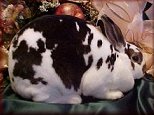
BrokenBROKEN as a general rule should be bred to a solid colored rabbit of their same color. Can also be bred to a REW or another broken.(From the Article in the NMRC Guidebook by Diane Campbell)(See Authors personal opinion below) If you use two brokens make sure they both carry a lot of pattern in order to prevent a litter full of charlies. (Personal Opinion: If brokens are your goal then breed broken to broken and generally cull the solids from these crosses as their color is usually not desirable. A broken to a solid without broken behind it can result in many booted rabbits) BROKEN - consists of any recognized breed variety color with white. The eye color is to correspond with the color specified under the respective solid colored variety. White toe nails preferred but a colored nails is not a dq. An evenly balanced pattern may garner more points than an unbalanced pattern.. (No preference given for a butterfly over nose spots)
Subscribe to:
Post Comments (Atom)
Wp Theme by Promiseringsdesigns | Blogger Template by Anshul

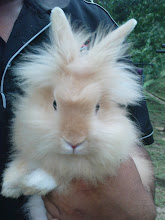
0 comments:
Post a Comment